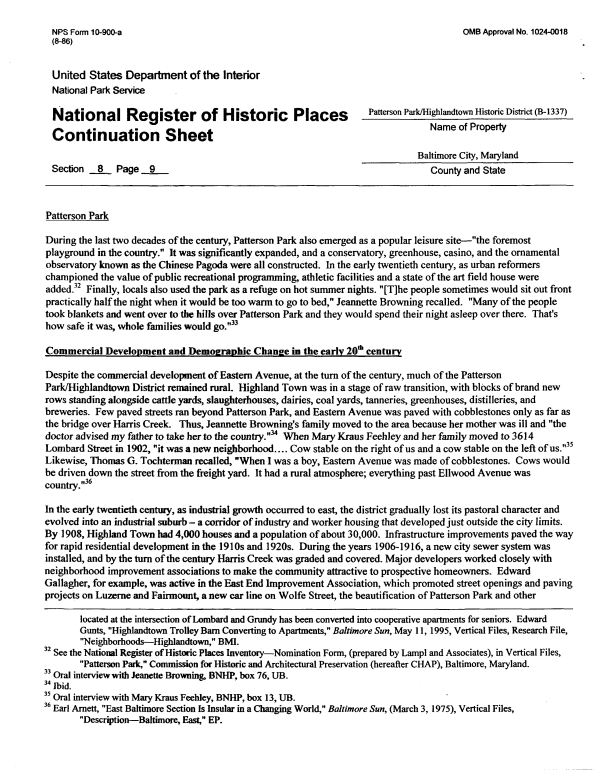 |
||||
|
DEPARTMENT OF HOUSING AND COMMUNITY DEVELOPMENT, MARYLAND HISTORICAL TRUST (Historic Sites Survey) var.d. MSA SE16-3 Image No: se16-3-0104 Enlarge and print image (86K) |
 |
||||
|
DEPARTMENT OF HOUSING AND COMMUNITY DEVELOPMENT, MARYLAND HISTORICAL TRUST (Historic Sites Survey) var.d. MSA SE16-3 Image No: se16-3-0104 Enlarge and print image (86K) |
| NPS Form 10-900-a OMB Approval No. 1024-0018 (8-86) United States Department of the Interior National Park Service person National Register of Historic Places ** «. -• *%• * Name of Property Continuation Sheet Baltimore City, Maryland Section _8L_ Page 9 County and State Patterson Park During the last two decades of the century, Patterson Park also emerged as a popular leisure site—"the foremost playground in the country." It was significantly expanded, and a conservatory, greenhouse, casino, and the ornamental observatory known as the Chinese Pagoda were all constructed. In the early twentieth century, as urban reformers championed the value of public recreational programming, athletic facilities and a state of the art field house were added.32 Finally, locals also used the park as a refuge on hot summer nights. "[T]he people sometimes would sit out front practically half the night when it would be too warm to go to bed," Jeannette Browning recalled. "Many of the people took blankets and went over to the hills over Patterson Park and they would spend their night asleep over there. That's how safe it was, whole families would go."33 Commercial Development and Demographic Change in the early 20th century Despite the commercial development of Eastern Avenue, at the turn of the century, much of the Patterson Park/Highlandtown District remained rural. Highland Town was in a stage of raw transition, with blocks of brand new rows standing alongside cattle yards, slaughterhouses, dairies, coal yards, tanneries, greenhouses, distilleries, and breweries. Few paved streets ran beyond Patterson Park, and Eastern Avenue was paved with cobblestones only as far as the bridge over Harris Creek. Thus, Jeannette Browning's family moved to the area because her mother was ill and "the doctor advised my father to take her to the country."34 When Mary Kraus Feehley and her family moved to 3614 Lombard Street in 1902, "it was a new neighborhood.... Cow stable on the right of us and a cow stable on the left of us." Likewise, Thomas G. Tochterman recalled, "When I was a boy, Eastern Avenue was made of cobblestones. Cows would be driven down the street from the freight yard. It had a rural atmosphere; everything past Ellwood Avenue was country."36 In the early twentieth century, as industrial growth occurred to east, the district gradually lost its pastoral character and evolved into an industrial suburb- a corridor of industry and worker housing that developed just outside the city limits. By 1908, Highland Town had 4,000 houses and a population of about 30,000. Infrastructure improvements paved the way for rapid residential development in the 1910s and 1920s. During the years 1906-1916, a new city sewer system was installed, and by the turn of the century Harris Creek was graded and covered. Major developers worked closely with neighborhood improvement associations to make the community attractive to prospective homeowners. Edward Gallagher, for example, was active in the East End Improvement Association, which promoted street openings and paving projects on Luzerne and Fairmount, a new car line on Wolfe Street, the beautification of Patterson Park and other located at the intersection of Lombard and Grundy has been converted into cooperative apartments for seniors. Edward Gunts, "Highlandtown Trolley Barn Converting to Apartments," Baltimore Sun, May 11, 1995, Vertical Files, Research File, "Neighborhoods—Highlandtown," BMI. 32 See the National Register of Historic Places Inventory—Nomination Form, (prepared by Lampl and Associates), in Vertical Files, "Patterson Park," Commission for Historic and Architectural Preservation (hereafter CHAP), Baltimore, Maryland. 33 Oral interview with Jeanette Browning, BNHP, box 76, UB. 34 Ibid. 35 Oral interview with Mary Kraus Feehley, BNHP, box 13, UB. 36 Earl Amett, "East Baltimore Section Is Insular in a Changing World," Baltimore Sun, (March 3, 1975), Vertical Files, "Description—Baltimore, East," EP. |